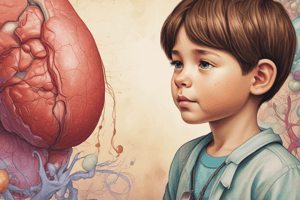Podcast
Questions and Answers
What is the primary cause of chronic liver injury that leads to liver cirrhosis?
What is the primary cause of chronic liver injury that leads to liver cirrhosis?
- Autoimmune hepatitis and bile duct obstruction
- Alcoholic liver disease and non-alcoholic fatty liver disease
- Viral hepatitis (A and E)
- Viral hepatitis (B and C) (correct)
Which of the following is a characteristic of decompensated cirrhosis?
Which of the following is a characteristic of decompensated cirrhosis?
- Jaundice and palmar erythema
- Fatigue and weakness
- Loss of appetite and nausea
- Ascites and variceal bleeding (correct)
What is the most accurate diagnostic test for liver cirrhosis?
What is the most accurate diagnostic test for liver cirrhosis?
- Liver biopsy (correct)
- Liver function tests (LFTs)
- CT or MRI scan
- Ultrasound
Which of the following is not a sign of liver cirrhosis?
Which of the following is not a sign of liver cirrhosis?
What is the treatment approach for liver cirrhosis?
What is the treatment approach for liver cirrhosis?
Which of the following is a complication of decompensated cirrhosis?
Which of the following is a complication of decompensated cirrhosis?
Flashcards are hidden until you start studying
Study Notes
Definition and Pathophysiology
- Liver cirrhosis is a chronic liver disease characterized by the replacement of normal liver tissue with scar tissue, leading to loss of liver function.
- It is a result of chronic liver injury, which can be caused by various factors such as:
- Viral hepatitis (B and C)
- Alcoholic liver disease
- Non-alcoholic fatty liver disease (NAFLD)
- Autoimmune hepatitis
- Bile duct obstruction
Stages of Liver Cirrhosis
- Compensated cirrhosis: The liver still functions adequately despite scarring, but may have symptoms such as fatigue and weakness.
- Decompensated cirrhosis: The liver function is impaired, leading to symptoms such as:
- Ascites (fluid accumulation in the abdomen)
- Variceal bleeding (bleeding from esophageal or gastric varices)
- Encephalopathy (confusion, altered mental status)
Clinical Features
- Symptoms:
- Fatigue
- Weakness
- Loss of appetite
- Nausea and vomiting
- Abdominal pain
- Jaundice (yellowing of the skin and eyes)
- Signs:
- Palmar erythema (redness of the palms)
- Spider nevi (small, spider-like blood vessels on the skin)
- Gynecomastia (breast enlargement in men)
- Testicular atrophy (shrinkage of the testes)
Diagnosis
- Laboratory tests:
- Liver function tests (LFTs)
- Complete blood count (CBC)
- Coagulation studies
- Imaging studies:
- Ultrasound
- CT or MRI scan
- Liver biopsy: The gold standard for diagnosing cirrhosis, but not always necessary
Treatment and Management
- Treatment of underlying causes (e.g. antiviral therapy for viral hepatitis)
- Management of complications:
- Ascites: diuretics and paracentesis (fluid removal)
- Variceal bleeding: endoscopic therapy and beta blockers
- Encephalopathy: lactulose and rifaximin
- Liver transplantation: The only cure for end-stage liver cirrhosis
Studying That Suits You
Use AI to generate personalized quizzes and flashcards to suit your learning preferences.



